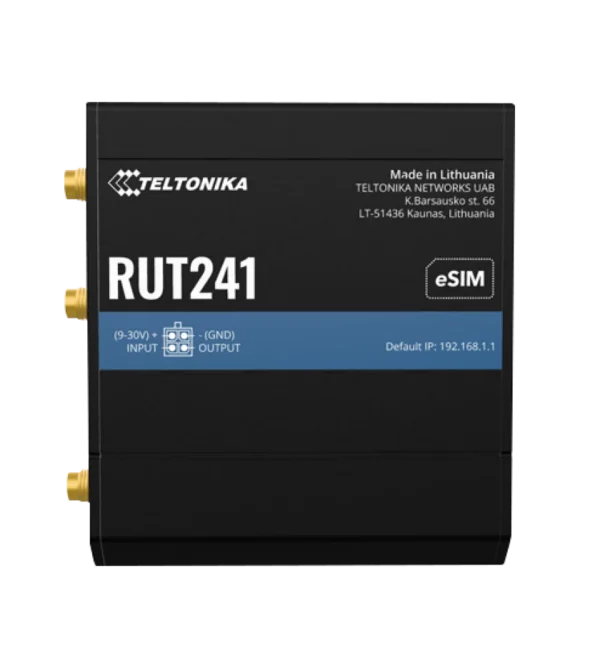Teltonika RUT241: A Compact Industrial 4G eSIM Router Built for Reliable IoT, M2M, and Everyday Connectivity
The Teltonika RUT241 is an entry level industrial-grade 4G LTE router designed for M2M & IoT use cases. This router is also useful in backup connectivity scenarios.
This articles focuses on the technical aspects and advantages of Teltonika RUT241 router.

Introduction
This compact yet powerful cellular router built for reliable connectivity in IoT, M2M, and remote applications. Designed with durability and flexibility in mind, it supports 4G LTE, Wi-Fi, and two Ethernet ports, making it suitable for a wide range of use cases, from industrial setups to smart infrastructure and mobile systems. The router also supports Teltonika’s Remote Management System (RMS), so you can monitor and manage your devices from anywhere.
A standout feature is its support for eSIM™ based on the SGP.22 architecture. This allows up to seven eSIM™ profiles alongside a physical SIM. There’s also a non-eSIM™ model for those who prefer traditional SIM-only configurations.
Teltonika Networks is the leading networking products manufacturers made in EU.
Key Features of the Teltonika RUT241 at a Glance
- Industrial-Grade Design – Durable with aluminium housing, compact, and built to operate in harsh environments (-40°C to +75°C).
- 4G LTE (Cat 4) Connectivity – Delivers mobile internet speeds up to 150 Mbps download / 50 Mbps upload.
- Wi-Fi & Ethernet Support – Includes 1× WAN and 1× LAN Ethernet ports, plus Wi-Fi access point functionality.
- Automatic WAN Failover – Ensures uninterrupted internet by switching between available connections.
- Advanced RutOS – Secure and feature-rich operating system with support for VPN, Firewall, DDNS, SSH, etc.
- Remote Management (RMS) Ready – Full compatibility with Teltonika’s RMS platform for easy monitoring and remote access.
- eSIM™ Support (SGP.22) – Manage up to 7 eSIM profiles alongside a physical SIM; ideal for global deployments.
- Digital I/O Ports – Supports automation and remote monitoring with configurable input/output options.
- Compact & Easy to Deploy – Small form factor, DIN rail mountable, and quick setup for fast integration.
- Global Certifications – Meets multiple regional compliance standards for worldwide use.
Technical Specifications
Mobile
- Mobile module
4G LTE Cat 4 up to 150 DL/50 UL Mbps; 3G up to 21 DL/5.76 UL Mbps; 2G up to 236.8 DL/236.8 UL kbps - 3GPP Release
Release 10/11, depending on the hardware version - eSIM*
Consumer type eSIM, profile download and removal operations, up to 7 eSIM profiles; does not include data plans
*Feature availability varies by order code
- SIM switch*
1 x 2FF SIM and 1 x eSIM, auto-switch cases: weak signal, data limit, SMS limit, roaming, no network, network denied, data connection fail
*Feature availability varies by order code
- Status
IMSI, ICCID, operator, operator state, data connection state, network type, bandwidth, connected band, signal strength (RSSI), SINR, RSRP, RSRQ, EC/IO, RSCP, data sent/received, LAC, TAC, cell ID, ARFCN, UARFCN, EARFCN, MCC, and MNC - SMS
SMS status, SMS configuration, EMAIL to SMS, SMS to EMAIL, SMS to HTTP, SMS to SMS, scheduled SMS, SMS autoreply, SMPP - USSD
Supports sending and reading Unstructured Supplementary Service Data messages - Block/Allow list
Operator block/allow list (by country or separate operators) - Multiple PDN
Possibility to use different PDNs for multiple network access and services - Band management
Band lock, Used band status display - SIM PIN code management
SIM PIN code management enables setting, changing, or disabling the SIM card’s PIN - APN
Auto APN - Bridge
Direct connection (bridge) between the mobile ISP and the device on the LAN - Passthrough
The router assigns its mobile WAN IP address to another device on the LAN
Wireless
- Wireless mode
802.11b/g/n (Wi-Fi 4), Access Point (AP), Station (STA) - Wi-Fi security
WPA2-Enterprise: PEAP, WPA2-PSK, WPA-EAP, WPA-PSK, WPA3-SAE, WPA3-EAP, OWE; AES-CCMP, TKIP, Auto-cipher modes, client separation, EAP-TLS with PKCS#12 certificates, disable auto-reconnect, 802.11w Protected Management Frames (PMF) - SSID/ESSID
SSID stealth mode and access control based on MAC address - Wi-Fi users
Up to 50 simultaneous connections - Wireless Connectivity Features
Wireless mesh (802.11s), fast roaming (802.11r), Relayd, BSS transition management (802.11v), radio resource measurement (802.11k) - Wireless MAC filter
Allowlist, blocklist - Wireless QR code generator
Once scanned, a user will automatically enter your network without needing to input login information - TravelMate
Forward the Wi-Fi hotspot landing page to a subsequent connected device
Ethernet
- WAN
1 x WAN port 10/100 Mbps, compliance IEEE 802.3, IEEE 802.3u, 802.3az standards, supports auto MDI/MDIX - LAN
1 x LAN port, 10/100 Mbps, compliance with IEEE 802.3, IEEE 802.3u standards, supports auto MDI/MDIX
Network
- Routing
Static routing, Dynamic routing (BGP, OSPF v2, RIP v1/v2, EIGRP, NHRP), Policy based routing - Network protocols
TCP, UDP, IPv4, IPv6, ICMP, NTP, DNS, HTTP, HTTPS, SFTP, FTP, SMTP, SSL/TLS, ARP, VRRP, PPP, PPPoE, UPNP, SSH, DHCP, Telnet, SMPP, SNMP, MQTT, Wake On Lan (WOL), VXLAN - VoIP passthrough support
H.323 and SIP-alg protocol NAT helpers, allowing proper routing of VoIP packets - Connection monitoring
Ping Reboot, Wget Reboot, Periodic Reboot, LCP, and ICMP for link inspection - Firewall
Port forward, traffic rules, custom rules, TTL target customisation - Firewall status page
View all your Firewall statistics, rules, and rule counters - Ports management
View device ports, enable and disable each of them, turn auto-configuration on or off, change their transmission speed, and so on - Network topology
Visual representation of your network, showing which devices are connected to which other devices - Hotspot
Captive portal (hotspot), internal/external Radius server, Radius MAC authentication, SMS authorisation, SSO authentication, internal/external landing page, walled garden, user scripts, URL parameters, user groups, individual user or group limitations, user management, 9 default customisable themes and optionality to upload and download customised hotspot themes - DHCP
Static and dynamic IP allocation, DHCP relay, DHCP server configuration, status, static leases: MAC with wildcards - QoS / Smart Queue Management (SQM)
Traffic priority queuing by source/destination, service, protocol, or port, WMM, 802.11e - DDNS
Supported >25 service providers; others can be configured manually - DNS over HTTPS
DNS over HTTPS proxy enables secure DNS resolution by routing DNS queries over HTTPS - Network backup
Wi-Fi WAN, Mobile, VRRP, Wired options, each of which can be used as an automatic Failover - Load balancing
Balance Internet traffic over multiple WAN connections - SSHFS
Possibility to mount a remote file system via the SSH protocol - Traffic Management
Real-time monitoring, wireless signal charts, and traffic usage history
Security
- Authentication
Pre-shared key, digital certificates, X.509 certificates, TACACS+, Internal & External RADIUS users authentication, IP & login attempts block, time-based login blocking, built-in random password generator - Firewall
Preconfigured firewall rules can be enabled via WebUI, unlimited firewall configuration via CLI, DMZ, NAT, NAT-T, and NAT64 - Attack prevention
DDOS prevention (SYN flood protection, SSH attack prevention, HTTP/HTTPS attack prevention), port scan prevention (SYN-FIN, SYN-RST, X-mas, NULL flags, FIN scan attacks) - VLAN
Port and tag-based VLAN separation - Mobile quota control
Mobile data limit, customizable period, start time, warning limit, phone number - WEB filter
Black list for blocking out unwanted websites, allow list for specifying allowed sites only - Access control
Flexible access control of SSH, Web interface, CLI, and Telnet - SSL certificate generation
Let’s Encrypt and SCEP certificate generation methods - 802.1x
Port-based network access control server
VPN
- OpenVPN
Multiple clients and a server can run simultaneously, with 27 encryption methods - OpenVPN Encryption
DES-CBC 64, RC2-CBC 128, DES-EDE-CBC 128, DES-EDE3-CBC 192, DESX-CBC 192,
BF-CBC 128, RC2-40-CBC 40, CAST5-CBC 128, RC2-64-CBC 64, AES-128-CBC 128, AES-128-CFB 128, AES-128-CFB1 128, AES-128-CFB8 128, AES-128-OFB 128, AES-128-GCM 128, AES-192-CFB 192, AES-192-CFB1 192, AES-192-CFB8 192, AES-192-OFB 192, AES-192-CBC 192, AES-192-GCM 192, AES-256-GCM 256, AES-256-CFB 256, AES-256-CFB1 256, AES-256-CFB8 256, AES-256-OFB 256, AES-256-CBC 256 - IPsec
XFRM, IKEv1, IKEv2, with 14 encryption methods for IPsec (3DES, DES, AES128, AES192, AES256, AES128GCM8, AES192GCM8, AES256GCM8, AES128GCM12, AES192GCM12, AES256GCM12, AES128GCM16, AES192GCM16, AES256GCM16) - GRE
GRE tunnel, GRE tunnel over IPsec support - PPTP, L2TP
Client/Server instances can run simultaneously, L2TPv3, and L2TP over IPsec support - Stunnel
Proxy is designed to add TLS encryption functionality to existing clients and servers without any changes in the program’s code - DMVPN
Method of building scalable IPsec VPNs, Phase 2 and Phase 3, and Dual Hub support - SSTP
SSTP client instance support - ZeroTier
ZeroTier VPN client support - WireGuard
WireGuard VPN client and server support - Tinc
Tinc offers encryption, authentication, and compression in its tunnels. Client and server support.
OPC UA
- Supported modes
Client, Server - Supported connection types
TCP
Modbus
- Supported modes
Server, Client - Supported connection types
TCP - Custom registers
MODBUS TCP custom register block requests, which read/write to a file inside the router, and can be used to extend the MODBUS TCP Client functionality - Supported data formats
8-bit: INT, UINT; 16-bit: INT, UINT (MSB or LSB first); 32-bit: float, INT, UINT (ABCD (big-endian), DCBA (little-endian), CDAB, BADC), HEX, ASCII
Data to Server
- Protocol
HTTP(S), MQTT, Azure MQTT - Data to server
Extract parameters from multiple sources and different protocols, and send them all to a single server; Custom LUA scripting, allowing scripts to utilize the router’s Data to server feature
MQTT Gateway
- Modbus MQTT Gateway
Allows sending commands and receiving data from the MODBUS Server through the MQTT broker
DNP3
- Supported modes
Station, Outstation - Supported connection
TCP
DLMS/COSEM
- DLMS Support
DLMS – standard protocol for utility meter data exchange - Supported modes
Client - Supported connection types
TCP
API
- Teltonika Networks Web API (beta) support
Expand your device’s possibilities by using a set of configurable API endpoints to retrieve or change data. For more information, please refer to this documentation: https://developers.teltonika-networks.com
Monitoring & Management
- WEB UI
HTTP/HTTPS, status, configuration, FW update, CLI, troubleshoot, multiple event log servers, firmware update availability notifications, event log, system log, kernel log, Internet status - FOTA
Firmware update from the server, automatic notification - SSH
SSH (v1, v2) - SMS
SMS status, SMS configuration - Call
Reboot, Status, Mobile data on/off, Output on/off, answer/hang-up with a timer, Wi-Fi on/off - TR-069
OpenACS, EasyCwmp, ACSLite, tGem, LibreACS, GenieACS, FreeACS, LibCWMP, Friendly tech, AVSystem - MQTT
MQTT Broker, MQTT publisher - SNMP
SNMP (v1, v2, v3), SNMP Trap, Brute force protection - JSON-RPC
Management API over HTTP/HTTPS - RMS
Teltonika Remote Management System (RMS)
IoT Platforms
- ThingWorx
Allows monitoring of: WAN Type, WAN IP, Mobile Operator Name, Mobile Signal Strength, Mobile Network Type - Cumulocity – Cloud of Things
Allows monitoring of: Device Model, Revision and Serial Number, WAN Type and IP, Mobile Cell ID, ICCID, IMEI, Connection Type, Operator, Signal Strength. Has reboot and firmware upgrade actions - Azure IoT Hub
Can be configured with Data to Server to send all the available parameters to the cloud. Has Direct method support, which allows executing RutOS API calls on the IoT Hub. Also has Plug and Play integration with Device Provisioning Service that allows zero-touch device provisioning to IoT Hubs - AWS IoT Core
Utility to interact with the AWS cloud platform. Jobs Support: Call the device’s API using AWS Jobs functionality
System Characteristics
- CPU
Mediatek, 580 MHz, MIPS 24KEc - RAM
128 MB, DDR2 - FLASH storage
16 MB, SPI Flash
Firmware / Configuration
- WEB UI
Update FW from file, check FW on server, configuration profiles, configuration backup - FOTA
Update FW - RMS
Update FW/configuration for multiple devices at once - Keep settings
Update FW without losing the current configuration - Factory settings reset
A full factory reset restores all system settings, including the IP address, PIN, and user data, to the default manufacturer’s configuration
Firmware Customisation
- Operating system
RutOS (OpenWrt-based Linux OS) - Supported languages
Busybox shell, Lua, C, C++ - Development tools
SDK package with build environment provided - GPL customization
You can create your custom, branded firmware and web page application by changing colours, logos, and other elements in our firmware to fit your or your clients’ needs - Package Manager
The Package Manager is a service used to install additional software on the device
Input / Output
- Input
1 x Digital Input, 0 – 6 V detected as logic low, 8 – 30 V detected as logic high - Output
1 x Digital Output, Open collector output, max output 30 V, 300 mA - Events
Email, RMS, SMS - I/O juggler
Allows setting certain I/O conditions to initiate an event
Power
- Connector
4-pin industrial DC power socket - Input voltage range
9 – 30 VDC, reverse polarity protection; surge protection >31 VDC 10us max - PoE (passive)
Passive PoE over spare pairs. Possibility to power up through LAN1 port, not compatible with IEEE802.3af, 802.3at and 802.3bt standards, Mode B, 9 – 30 VDC - Power consumption
< 6.5 W Max
Physical Interfaces
- Ethernet
2 x RJ45 ports, 10/100 Mbps - I/O’s
1 x Digital Input, 1 x Digital Output on 4-pin power connector - Status LEDs
3 x Connection type status LEDs, 5 x Connection strength LEDs, 2 x LAN status LEDs, 1 x Power LED - SIM
1 x SIM slot (Mini SIM – 2FF), 1.8 V/3 V, external SIM holder - Power
1 x 4-pin power connector - Antennas
2 x SMA for LTE, 1 x RP-SMA for Wi-Fi antenna connectors - Reset
Reboot/User default reset/Factory reset button
Physical Specification
- Casing material
Aluminium housing, plastic panels - Dimensions (W x H x D)
83 x 25 x 74 mm - Weight
125 g - Mounting options
DIN rail, wall mount, flat surface (all require additional kit)
Operating Environment
- Operating temperature
-40 °C to 75 °C - Operating humidity
10% to 90% non-condensing - Ingress Protection Rating
IP30
Regulatory & Type Approvals
- Regulatory
CE, UKCA, ANRT, Kenya, ICASA, FCC, IC, PTCRB, NOM, RCM, KC, Giteki, IMDA, E-mark, CB, UL/CSA Safety, RoHS, REACH, R118 - Operator
AT&T, Verizon, T-Mobile, Uscellular
EMC Emissions & Immunity
- Standards
EN 55032:2015 + A11:2020
EN 55035:2017 + A11:2020
EN IEC 61000-3-2:2019
EN 61000-3-3:2013 + A1:2019
EN 301 489-1 V2.2.3
EN 301 489-17 V3.2.4
Final Draft EN 301 489-52 V1.2.0 - ESD
EN 61000-4-2:2009 - Radiated Immunity
EN IEC 61000-4-3:2020 - EFT
EN 61000-4-4:2012 - Surge Immunity (AC Mains Power Port)
EN 61000-4-5:2014 + A1:2017 - CS
EN 61000-4-6:2014 - DIP
EN 61000-4-11:2020
RF
- Standards
EN 300 328 V2.2.2
EN 301 511 V12.5.1
EN 301 908-1 V15.2.1
EN 301 908-2 V13.1.1
EN 301 908-13 V13.2.1
Safety
- Standards
CE: EN IEC 62368-1:2020 + A11:2020, EN IEC 62311:2020, EN 50665:2017
RCM: AS/NZS 62368.1:2022
CB: IEC 62368-1:2018
UL/CSA Safety: UL 62368-1, Ed. 3 dated December 13, 20, CAN/CSA C22.2 No. 62368-1:19
Teltonika RUT241 Use Cases
1. Industrial Equipment Monitoring
Connecting remote machinery like PLCs or sensors to the internet for telemetry collections and diagnostics.
Features can be used: 4G connectivity, VPN, Modbus, RS485 to ethernet bridging via external converters.
2. Fleet Management & Telematics
Installed in trucks, buses, forklifts or any vehicle for GPS tracking, real-time data collection or WiFi access for the operator.
Features can be used: 9-30V input support, SMS/reboot, GPS with add-ons & RMS (Remote Management System).
3. Retail / POS Failover Internet
4G LTE backup for Point of Sales systems in retail stores, kiosks or vending machine in indoor or outdoor area.
Features can be used: 4G LTE Failover via WAN, SMS control, VPN, RMS.
4. Surveillance & CCTV Remote Access
Deploying cameras in remote and rugged sites like warehouses, farms, parking lots.
Features can be used: Built-in Firewall, port forwarding, VPN support, RMS.
5. Temporary Events & Pop-up Installations
Internet access for event booths, construction sites, roadshows or mobile labs.
Features can be used: 4G LTE, WiFi
6. Energy & Utilities
Connecting meters, solar inverters, or remote substations to SCADA or central monitoring systems.
Features can be used: Operate in harsh weather conditions, supports secure protocols, and integrated with energy monitoring tools.
7. Smart Access Control Systems
Connecting electronic gates, door controllers, or parking system to cloud based management.
Features can be used: Reliable 4G cellular links with low power draw and remote rebooting
8. Digital Signage and Info Kiosks
Teltonika RUT241 can be used to power digital signage displays in shopping malls, airports, or outdoor tram stations that remote remote updates.
Features can be used: LTE connectivity, content delivery via VPN, secure FTP
Conclusion
In short, the Teltonika RUT241 is a compact, industrial-grade router that delivers stable and secure connectivity in demanding environments. With support for 4G LTE, eSIM, Wi-Fi, and Ethernet, it’s built to keep your devices online no matter where you are.


